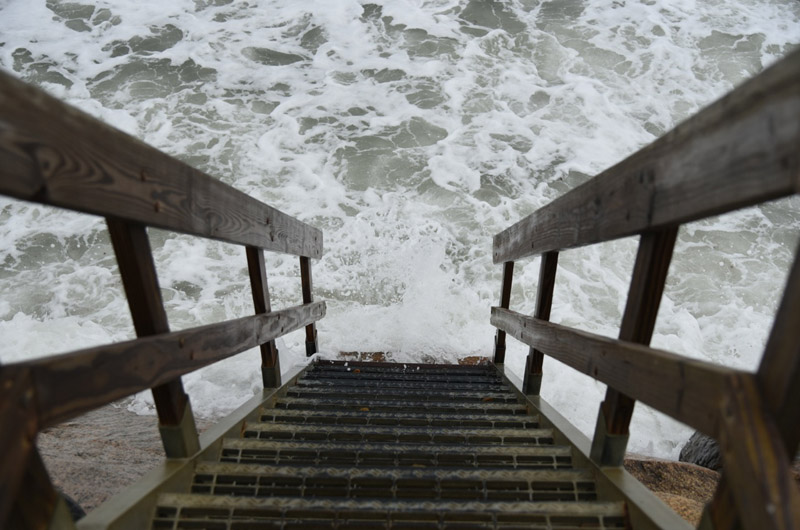Almost two years after Chilmark voters unanimously backed a plan to restore the eroding Squibnocket Beach, the project remains mired in litigation, with an appeal to the town zoning board still pending as of this week.
As one result, the town missed a planned October start date that would have allowed it to use a $280,000 grant from the state office of Coastal Zone Management to pay for part of the project. It was the second such grant the town had received since 2014 and been unable to spend due to the ongoing public debate. The town reapplied for a third time last year, raising the amount to $400,000, but was denied.
Town conservation agent Chuck Hodgkinson, who is coordinating the project, said this week that he wasn’t sure why the grant was denied, although it was clear why the previous grant had slipped away. “That grant expired, and we weren’t able to spend all of it, and we applied again and we were denied,” he said.
From the two grants, the town spent a total of $72,000 on engineering, permitting, legal expenses and archaeological surveys. But construction has yet to begin.
The two-part project, involving both the town and the Squibnocket Farm Homeowners Association, had emerged from a months-long public review in 2014 following a contentious town meeting that year when voters narrowly rejected a proposal they felt had fallen short in terms of transparency and consideration of alternatives. In a dramatic turnaround, voters unanimously approved the final recommendation of a town review committee in February 2015.
More than a year later, the Martha’s Vineyard Commission and town conservation commission both unanimously approved the final plans, which include the removal of old revetment stones and relocation of a parking lot at the water’s edge. The appeal focuses only on the private portion of the project, which features an elevated causeway running through wetlands between the ocean and Squibnocket Pond.
Doug Liman, a resident of Blacksmith Valley, which overlooks the barrier beach that has eroded significantly in the last few decades, filed the most recent appeal in August, arguing that the town building inspector was wrong to determine that the project complied with town zoning rules and did not require a building permit.
Building inspector Leonard Jason Jr. had determined in a letter dated August 3 that the proposed causeway to the homes at Squibnocket Farm “constitutes a relocated roadway and is not a structure,” as defined in the town zoning bylaws.
In his appeal, Mr. Liman acknowledged the desire of town residents to put the controversy behind them. “We recognize that requiring a building permit will subject the causeway to strict zoning requirements of the Squibnocket overlay district and likely result in yet another town meeting and vote to amend the bylaws, and that many people would prefer to avoid this outcome including this author,” he wrote.
According to the town bylaws, a structure is a “combination of materials assembled at a fixed location to give support or shelter, or act as a barrier,” with roads not specified among the few examples. Another set of bylaws limits the area within 100 feet of the shoreline to existing uses and various maintenance activities, with structures for fishing and aquaculture allowed only by special permit.
The question is whether a relocated roadway within 100 feet of the shore would violate the bylaws. Mr. Jason beleives it would not. But Mr. Liman argued, among other things, that the project does not entail a relocated roadway, since removing the existing roadway would take place under a separate application by the town.
An earlier appeal that Mr. Liman initiated by petition took aim at the town conservation commission, asking the state Department of Environmental Protection (DEP) to issue a superseding order of conditions after the commission approved the project in May. In December, the DEP did in fact issue the order, although Mr. Hodgkinson said it merely reinforces the existing conditions and upholds the commission’s approval. A 10-day window to appeal the decision closed Dec. 25.
The MVC approval last spring was not appealed. Mr. Liman did not immediately respond to requests for comment this week.
Town officials had expected the projects to start last October, with completion by Memorial Day. Rather than using the state grant, the town would have relied on $350,000 in appropriations by voters in recent years for costs related to the town portion of the project. The cost of the causeway will be paid by the homeowners association, but the town portion cannot go forward on its own since removing the parking lot and revetment stones would also remove access to Squibnocket Farm.
Mr. Hodgkinson said the town will reapply for the state grant in the amount of $400,000, assuming the program continues in the next fiscal year. But for now, he said, it’s a matter of waiting for the outcome of the latest appeal, which could come at any time and could itself be appealed. “It’s a long, long process,” he said.








Comments (6)
Comments
Comment policy »